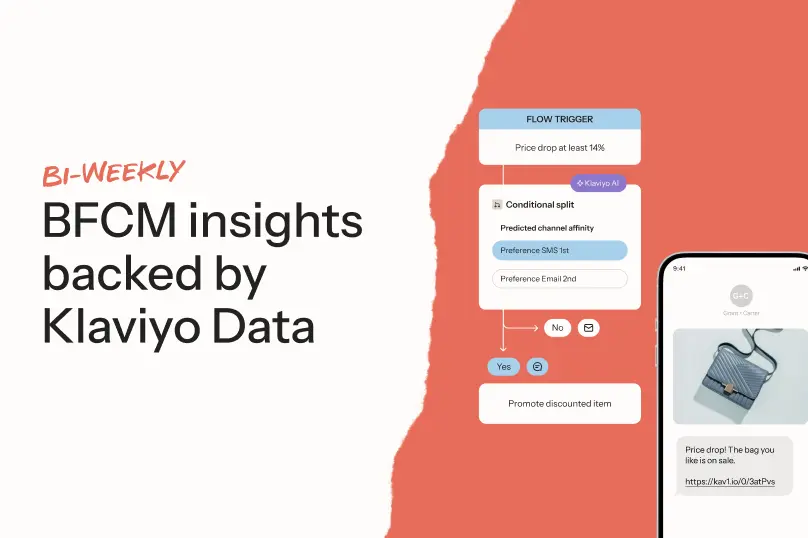9 Cyber Monday strategies that actually drive results

Cyber Monday is one of the biggest revenue opportunities of the year. Shoppers spent $13.3 billion on Cyber Monday 2024, over 7% more than the previous year, according to Adobe Analytics.
But that Monday after Thanksgiving is also when your customers’ inboxes are more crowded than ever. Standing out requires more than just slapping a discount on your products and hitting send. The brands that win big are the ones with strategic, channel-optimized campaigns that deliver the right message to the right person at the right time.
As founder of Zettler Digital, I’ve spent over a decade optimizing sales for brands over Black Friday Cyber Monday (BFCM).
Here are 9 proven strategies to make your Cyber Monday campaign a standout success.
1. Don’t automatically increase your discount from Black Friday
Bigger percentage discounts from Friday to Monday can create customer service nightmares and train people to wait for deeper discounts. They also erode trust. You want your customers to know that when you make an offer, it’s one they can count on, and that they won’t feel duped or taken advantage of just a few days later.
“Teasing an upcoming bigger or different deal in your Black Friday emails can lead to a drop-off in Black Friday incentive uptake rates and mess up your reporting and inventory as well,” says Stefan Milicevic, strategy director at Underground Ecom.
To avoid these issues, consider offering a uniquely different incentive for Cyber Monday instead of a bigger discount.
Teasing a different deal in your Black Friday emails can mess up your reporting and inventory.
2. Create a unified messaging calendar across all channels
Your Black Friday Cyber Monday messaging should feel cohesive whether subscribers see it on Instagram, in their email, or via text message. That’s true not only on Black Friday and the days leading up to it, but through Cyber Monday as well.
This means aligning your communications to create one unified view of your brand’s messaging across:
- Organic social
- Paid ads
- Influencer partnerships
- Any other content, such as pop-ups on your site
Too many brands miss this opportunity by treating each channel—and each big day—as a separate campaign. Instead, map out what message hits when and where. Your customers interact with your brand across multiple touchpoints. Make sure those interactions feel intentional and connected.
3. Optimize content for each individual channel
It amazes me how many brands put out content that’s completely wrong for the channel. Instagram ads get cut off because assets aren’t sized properly. Email content looks terrible on mobile.
These technical details matter more than the average marketer may realize. It’s important to consider your content for Cyber Monday as well as what you put out ahead of Thanksgiving.
Before you launch, double-check that your assets are optimized for each channel. Here are a few ideas:
- Properly size images for Instagram stories vs. feed posts.
- Make sure your email templates look great on both desktop and mobile.
- Test that your text messages display correctly across different devices.
The fix is simple: prep your assets beforehand with each platform’s specifications in mind. Don’t let poor formatting kill an otherwise great campaign.
4. Use exclusion logic based on preferred channels
Channel affinity—AI that uses historical engagement data to predict which channel a subscriber is most likely to engage with next—is one of the most underutilized features in marketing.
If you’re using Klaviyo, channel affinity preferences automatically show up as profile properties—and they can be game-changers for your Cyber Monday strategy.
Here’s why this matters: Cyber Monday means high volume from every brand, which drives up costs and creates deliverability concerns. Channel affinity helps you be more efficient by identifying which subscribers are more likely to convert via text message vs. email or push notifications.
If you have 10,000 people on your list and 1,000 of them are more likely to convert from text message marketing, move them there. You’re likely to see better results and lower costs while reducing the risk of overwhelming people with messages on channels they don’t prefer.
5. Set up triggered messaging based on prior actions
One of the biggest opportunities for Cyber Monday is to create triggered campaigns based on what customers did on Black Friday. With Klaviyo’s automated flows and Omnichannel Campaign Builder, you can schedule campaigns and personalized messages that bridge the entire sale period.
For example, set up a Black Friday campaign that tracks anyone who clicked and added items to their cart. If they haven’t completed their purchase by Cyber Monday, automatically trigger a message offering them a bonus $10 off orders of $100 or more, on top of your existing offer.
This approach lets you create personalized incentives without giving huge discounts to your entire list. You’re only rewarding customers who’ve already shown purchase intent, which is much more efficient than blanket promotions.
On the flip side, customers who did purchase on Black Friday should receive messaging focused on complementary products or accessories. The omnichannel campaign builder makes it easy to create this logic ahead of time, so you don’t have to scramble to set it up manually in real time.
6. Build anticipation with VIP early access
Early November is the perfect time to serve your existing VIP customers a pop-up asking if they want to be first to know about your Black Friday Cyber Monday offers. This creates a curated list of people who are likely to engage with your content and gives you a strong launch.
“We launch dedicated VIP early access list in mid-November, inviting high-value subscribers and recent purchasers to sign up,” says Zac Fromson, co-founder at Lilo Social, a full-funnel ecommerce growth agency. “This segment receives exclusive early-bird access to the Cyber Monday offer 12–24 hours in advance. It builds urgency, drives early revenue, and increases engagement with limited inventory or high-conversion bundles.”
VIP early access lists build urgency, drive early revenue, and increase engagement.
“Brands need to define who VIPs actually are very early,” Milicevic emphasizes. “Q4 can be a frenzy, with every customer seeming important. That’s why the ‘early release’ strategy may sometimes fall flat.”
If there isn’t a set of conditions that works specifically for your brand, Milicevic recommends using the tried and tested combination of:
- At least 2-3 placed orders
- Order value 2-3x the average
If you’re launching a new product or have limited inventory, create exclusive access windows. Promote signing up for text messages a few days before, then give text message subscribers access to your biggest sale an hour before everyone else.
The best part of creating this VIP list is that you can use it far beyond Cyber Monday. Use it strategically throughout the year for product launches or exclusive offers. It’s a great way to identify subscribers who are most likely to engage with your messaging.
Use the lead-up to the big day as a means to identify subscribers likely to engage with messaging, then create segments you contact throughout the year for early-access promotions and product launches.
Cyber Monday strategy tip: Leverage Klaviyo sign-up forms to build this list in addition to identifying highly-engaged subscribers through segmentation. Consider a form that specifically speaks to subscribers that are already in your primary email or SMS list.
Brands need to define who VIPs actually are very early.
7. Use zero-party data to personalize bundle offers
Zero-party data—information customers willingly share with you—is incredibly valuable for creating personalized experiences. A simple quiz about preferences or gifting needs can provide the insights you need to create targeted bundle offers that feel custom-made for each customer.
“In the weeks leading up to Cyber Monday, we run a quiz or preference-based campaign to collect insights on customer interests—product types, budget, gifting needs,” Fromson explains. “Then, we segment the list and send personalized emails with curated bundles or product picks. Higher click-through rates and AOVs usually follow.”
Like your VIP list, you can continue to use this data year-long.
In the weeks leading up to Cyber Monday, we run a quiz or to collect insights on customer interests. Then, we send personalized emails with curated bundles. Higher click rates and AOVs usually follow.
8. Deploy an abandoned cart + deadline reminder strategy
Cyber Monday is one of the few times when it’s acceptable to use high-pressure tactics. Customers expect urgency and limited-time offers during this period.
You can approach this in two ways:
- Add a universal banner to your existing abandoned cart flows that highlights your Cyber Monday deadline.
- Create entirely new Cyber Monday-specific flows with wider messaging changes and fewer individual messages.
“We tighten our abandoned cart and browse abandonment automations with a real-time Cyber Monday overlay, reminding shoppers how much time is left, what they’re missing, and what’s popular,” says Fromson. “We pair that with a one-time ‘final hours’ campaign in the evening to trigger FOMO and drive last-minute conversions.”
We tighten some automations with real-time Cyber Monday overlay, reminder shoppers how much time is left, what they’re missing, and what’s popular.
Cyber Monday strategy tip: Use Klaviyo universal blocks to ease implementation across multiple messages.
9. Be honest about inventory and deadlines
When your sale ends, let it end. It can be easy to extend a promotion a few days past Cyber Monday—if that’s what’s best for your brand. But if you’ve mentioned a deadline, stick to it.
The same goes with limited inventory: if you’ve told your audience there’s limited stock, make sure that’s actually true.
“In most cases, it’s worth stating exactly how many pieces you have left per your Shopify records,” says Milicevic. “This should have the same effect as just communicating ‘limited stock.’”
“In our tests, showing the exact number of products left in stock vs. using generic terms like ‘a few’ or ‘running out’ wins by a hefty margin—50% more clicks on average,” Milicevic adds.
In our tests, showing the exact number of products left in stock vs. using generic terms like ‘a few’ wins by a hefty margin.
Lying about scarcity can get you into legal trouble and damage customer trust.
Cyber Monday is just around the corner
Cyber Monday success isn’t just about sending more emails or offering deeper discounts. It’s about being strategic with your messaging, personalizing the experience, and using data to send the right message to the right customer at the right time.
The brands that win are the ones that treat Cyber Monday as part of a larger customer journey, not just a one-day sales event. By implementing these strategies, you’ll create campaigns and flows that drive revenue while building stronger relationships with your customers.
Ready to make this your best Cyber Monday yet? Start planning your unified messaging calendar today.

Related content

Learn 5 ways to turn new holiday shoppers into repeat buyers using personalization, seamless returns, targeted outreach, and AI-driven customer experiences.

Learn what to include in your photography style guide to create consistent, on-brand visuals across your B2C marketing channels.

Shopping is about to hit its peak season. But this year’s surge will look different from those before it. Instead of impulsive buying sprees, shoppers are entering the holidays with a more deliberate mindset.